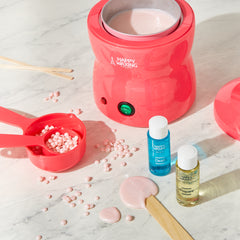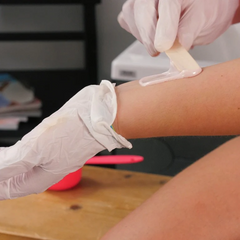First Time Waxing Myself: What Should I Do?
The journey into DIY waxing unfolds a world of independence in personal grooming, offering the allure of achieving salon-quality results within the sanctuary of home. This method, celebrated for its effectiveness and economy, allows for a tailored approach to hair removal, ensuring both convenience and privacy. Yet, for those standing at the threshold of their first waxing endeavor, the process might appear fraught with uncertainty. This comprehensive guide is designed to demystify the waxing process, providing first-timers with the confidence needed to embark on a successful and safe self-waxing journey.
Choosing the Right Waxing Supplies
Home Waxing Kits and Wax Types

Embarking on the DIY waxing path begins with the selection of the right tools. The market is awash with home waxing kits designed to cater to a spectrum of needs, from sensitive skin formulas to eco-friendly options. Understanding the distinction between soft and hard waxes is pivotal; soft waxes are ideal for larger areas like the arms and legs due to their efficiency in removing finer hair, while hard waxes are best suited for sensitive regions, offering a less painful removal by adhering to the hair rather than the skin.
Waxing Techniques

The technique employed can significantly impact the waxing experience. For areas with coarse hair, such as the bikini line or underarms, a firm application of hard wax ensures a grip strong enough to remove stubborn hair. Conversely, soft wax, applied thinly and removed with a strip, may be preferable for its ease of use on larger, less sensitive areas. Familiarizing oneself with the chosen kit’s instructions is essential for achieving optimal results.
Preparing for Waxing
Pre-Wax Preparation

Proper skin preparation is a cornerstone of effective waxing. Cleansing the area to be waxed removes impurities and oils, allowing the wax to adhere properly to the hair.
Gentle exfoliation, performed a day prior, clears away dead skin cells, reducing the risk of ingrown hairs and ensuring a smoother waxing surface.
Hair Length and Skin Sensitivity

Achieving the correct hair length, approximately ¼ inch, is crucial for the wax to effectively grip the hair. For those with sensitive skin, a patch test of the wax on a small, inconspicuous area 24 hours before the full application is advised to check for adverse reactions.
The Waxing Process
Application Process

Mastery over the wax’s temperature is crucial; it should be warm enough to spread easily but not so hot as to cause burns. Applying the wax in the direction of hair growth and removing it against this direction ensures the most thorough hair removal. Ensuring the skin is taut during removal can significantly reduce discomfort.
Pain Reduction

Managing pain is a primary concern for many first-timers. Techniques such as using a numbing cream prior to waxing or taking an over-the-counter pain reliever can dull the discomfort. The speed and confidence of the removal stroke also play a critical role in minimizing pain.
Removal Strategy

A swift, confident pull parallel to the skin, rather than upwards, minimizes pain and effectively removes hair. Hesitation or incorrect technique can lead to broken hairs or unnecessary pain, emphasizing the importance of following a proper removal strategy.
Aftercare and Maintenance
Aftercare Tips
 Immediately following waxing, applying a soothing lotion or aloe vera can help calm the skin and reduce redness. It’s important to avoid heat and friction, so skipping the gym, hot showers, and tight clothing for the first 24 hours is advised.
Immediately following waxing, applying a soothing lotion or aloe vera can help calm the skin and reduce redness. It’s important to avoid heat and friction, so skipping the gym, hot showers, and tight clothing for the first 24 hours is advised.
Ingrown Hair Prevention

Regular, gentle exfoliation between waxing sessions is key to preventing ingrown hairs, keeping the skin clear and smooth. Hydrating the skin daily supports its natural barrier, further reducing the likelihood of ingrown hairs.
Post-Wax Skin Care
Continuing a routine of gentle skin care after waxing supports long-term skin health. This includes using mild, fragrance-free products to cleanse and moisturize, preserving the skin’s smoothness and reducing irritation.
Common Mistakes and Safety Tips

Avoiding common waxing mistakes, such as waxing over the same area multiple times or neglecting skin prep and aftercare, can prevent many of the pitfalls associated with first-time waxing. Prioritizing safety through measures like temperature checks and maintaining a clean workspace can prevent accidents and infections.
Additional Tips for First-Timers
First-Time Tips
Starting with less sensitive areas, such as the legs, can provide valuable practice before moving on to more challenging regions. Patience and practice are essential, as proficiency in waxing, like any skill, develops over time.
Waxing Benefits
The benefits of waxing extend beyond the immediate results of smooth skin. Regular waxing can lead to thinner, sparser hair growth over time and can exfoliate the skin, leaving it softer and healthier.
Reusable Strips
For those opting for soft wax with strips, choosing reusable options can offer an eco-friendly, cost-effective alternative. Proper care and cleaning of these strips ensure their longevity and performance.
Conclusion
Stepping into the world of DIY waxing is an empowering move towards personalized beauty care. With the right preparation, tools, and technique, first-time waxers can achieve professional-grade results in the comfort of their own homes. Remember, the journey to waxing proficiency is a gradual one; each session builds skill and confidence. By embracing patience and adhering to these guidelines, the transition from novice to adept waxer can be both rewarding and transformative.




Leave a comment